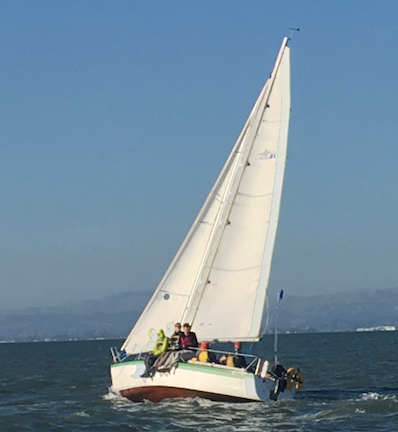Hi Racers, (and cruisers who like to make good time upwind),
Our racing venue tends to create a ‘parade’ between the start and the end of the channel and the first chance boats have to separate and seek strategic advantage is on the windward leg. The boats with the best upwind technique tend to make it to the windward mark among the leaders, even if they don’t get a front row start. So what does great upwind technique look like? Brett and his crew gave a clinic on this topic in a race, let’s take a look.

- The hull is perfectly trimmed fore and aft. The crew on the rail are close together and on the widest part of the boat where their weight provides the greatest righting moment.
The main trimmer is forward in the cockpit, able to work the main sheet, the jib winch if needed and also keep an eye on the compass for lifts and headers.
The ‘weight forward’ positioning keeps the stern up and promotes a clean release of the stern wave, minimizing drag. Sitting the crew close together reduces the boat’s rotational inertia and allows the bow to more easily lift and drop, reducing the waves’ drag on the hull. - The hull is well trimmed side to side, with ~15° of heel. This is enough to give good feel at the tiller without requiring extra rudder angle to hold the boat on course. The more rudder angle the helm is using, the more drag the rudder creates. Go fast by keeping upwind rudder angle between five and eight degrees. If the helm has to use more than eight for more than a few seconds, sheet the main out. If the tiller drops to center, sheet the main tighter.
- Rig tension (backstay) is perfect. Back stay tension controls fore stay tension and jib entry, as well as mast bend. In this shot the fore stay is permitting to fall away just enough to put a little fullness into the leading edge of the jib, promoting good air flow and making it easier to sail the boat to the jib tell tales. Too much back stay or jib halyard tension makes the luff of the jib flatter and more sensitive to angle of attack, much easier to stall and makes the task of sailing to the tell tales much harder. Main halyard tension is also perfect, with good draft shape. Often the main halyard is over-tensioned. The sail should e hoisted until there are small wrinkles at the luff and the luff smoothed out on upwind legs using the cunningham.
- The mainsail is perfectly trimmed. The boom is up on the boat’s center-line (the traveler car is likely a few inches to windward) and the leech is in perfect tension, showing the lower three tell tales streaming and the one on the top batten just tucking behind the sail. This trim set-up helps the boat point high.
- The helm is laser focused on steering to the jib tell tales, adjusting to small wind shifts and keeping the boat ‘in the groove’. Because the helm is absolutely focused on keeping the boat up to speed, he relies on the crew to watch for other boats, for wind-shifts and for gusts.


